Nail polish: what is it and how to use it?
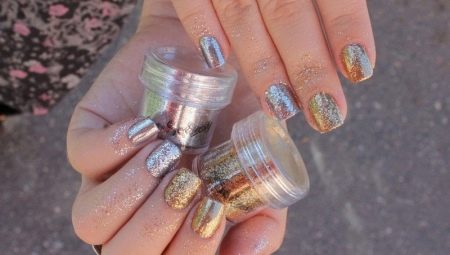
Fashion trends in manicure change season after season. Recently, manicure with the effect of a reflective surface has been at the peak of popularity. Contrary to the wishes of women of fashion, it cannot be done with varnish alone. To achieve a mirror effect, apply a nail polish. Manicurists know what it is and how to use it, but the secrets of the technology can be mastered at home.
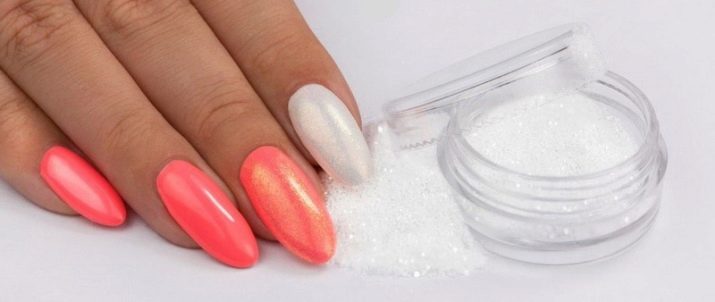
What it is?
The nail polish is a pigmented polyester powder. It has such a fine fraction that it looks like powder in consistency and appearance. Depending on the color of the polyester particles, a white, colorless or bright finish with a mirror shine is obtained on the nails.
The rubbing got its name for the way in which the powder is applied to the nail plate. A jar of powder comes with a special applicator or brush, which helps to collect the required amount of powder and evenly apply a layer on the nail.
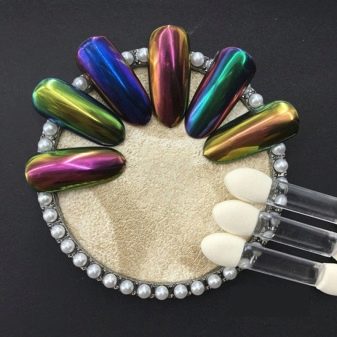
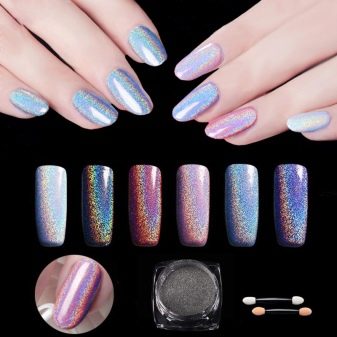
Any coating can serve as a base for rubbing: enamel, gel polish, shellac.
Depending on the method of application, a different result is possible: a monochrome coating, an accent on several nails, a jacket, decorative elements, a smooth or voluminous manicure.
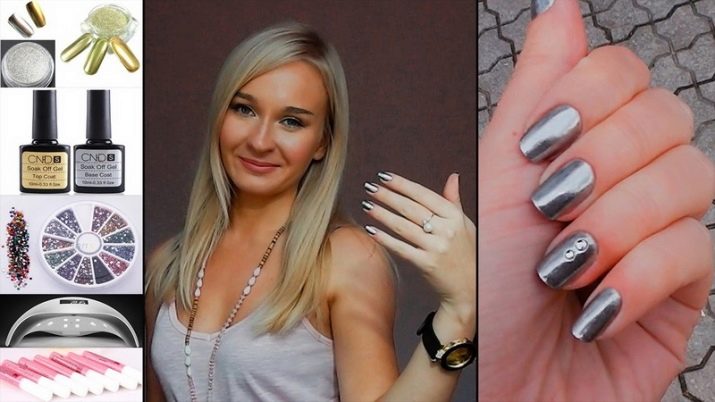
It is not difficult to apply rubbing, but it will take practice to master the technology. Changing the sequence of actions in a manicure using rubbing can give unpredictable results.
Varieties of material
A material is classified according to two criteria: the grind (particle size of the powder) and the effect it gives.
There are two main sizes used by manicurists.These dimensions are not numbered or marked. They are conventionally divided into powder and melange.
The powder is very fine, soft, free-flowing. With its help, they achieve a perfectly smooth coating and varying degrees of gloss.
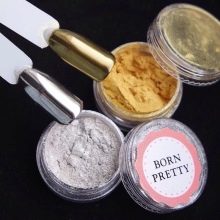
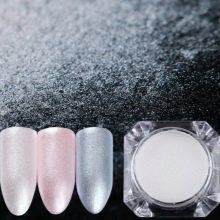
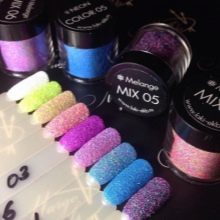
Melange are large particles. They are similar in appearance to acrylic sand. Melange is sometimes called "sugar", "marmalade" or "snow" manicure, which is quite true. A manicure with melange is voluminous, embossed, rubbing particles are visible under the top layer.
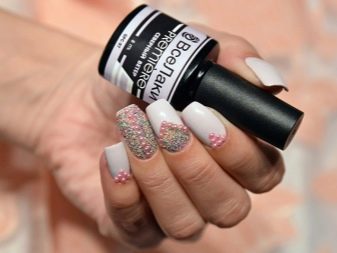
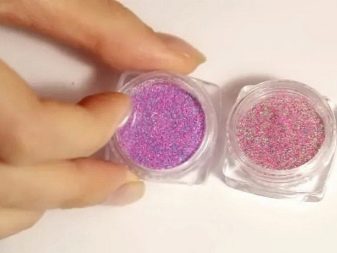
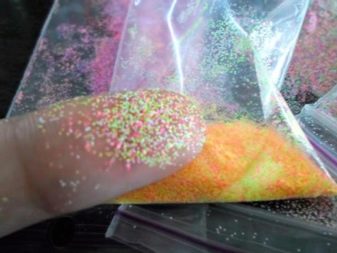
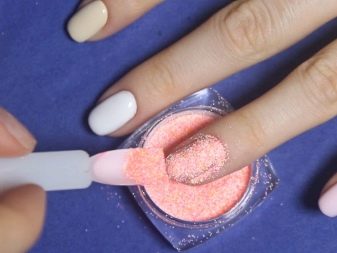
Sometimes a third type is distinguished - Yuki flakes. They got their name for their resemblance to snowflakes. They are unlike the previous species in size and shape. These are the finest and finest flakes with an iridescent surface. This effect is often referred to as a chameleon.
Yuki's flakes are very fragile. This is both a plus and a minus of the material. On the one hand, they can be ground into powder and divided into fragments of different sizes, or used as a whole. On the other hand, you need to work with them carefully so as not to accidentally destroy the plates.
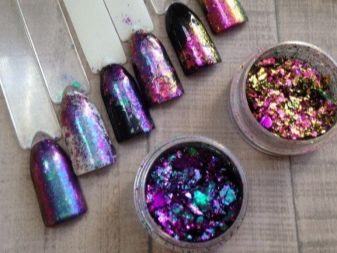
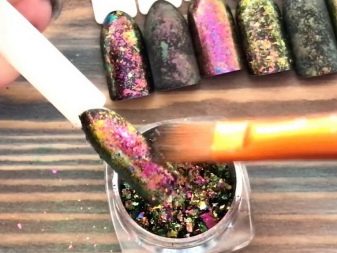
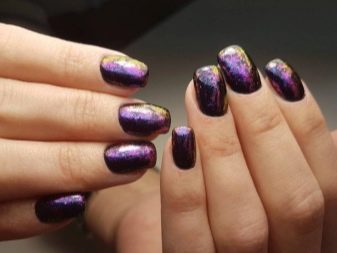

Many more varieties are distinguished by the type of coverage.
- Pearl rub. The color of the coating corresponds to the name. It is light, pale cream, gray-white, pale pink, with a bluish tint. The surface of the nail is pearlescent like pearls. This kind of material is popular for weddings and romantic looks. Suitable for identities and everyday wear. Relevant at any time of the year. Transparent, white, silver jewelry of small size is well combined with pearl rub: rhinestones, sparkles, caviar beads for manicure, velvet sand.
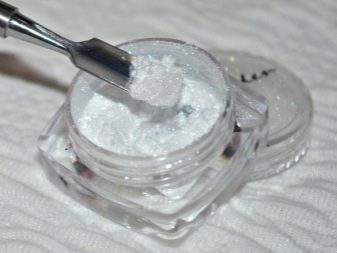
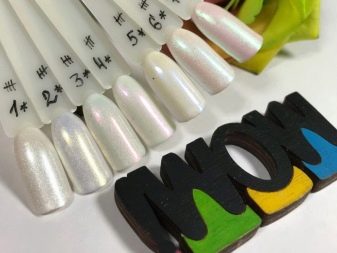

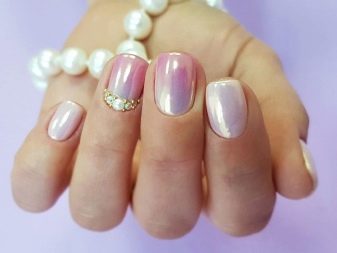
- "Unicorn". In appearance, it is similar to pearl, but the color is richer and warmer. Azure, pink, blue shades, the color of clear water are widespread. The "Unicorn" (sometimes called "Mermaid" or "Aurora") has a glossy surface that reflects light. Bright decorations are superfluous in such a manicure, but this type of rubbing is combined with matte coatings in the best possible way.
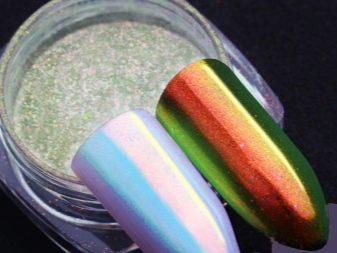
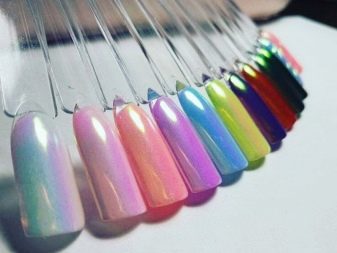
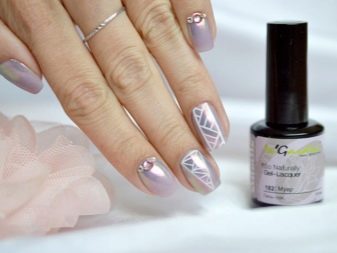
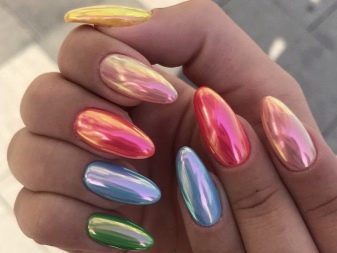
- Metallic. In the classic version, it has the color of precious metals: silver, gold, copper, platinum, bronze. But the palette of metallics has long gone beyond these colors. Today, a coating with this effect can be chosen in blue, yellow, red, green shades. The surface of the nails under the metallic looks polished. It is difficult to see your reflection in it, but nails catch and reflect light, drawing attention to a stylish manicure. Using several shades of the same color, you can create a gradient on your nails.
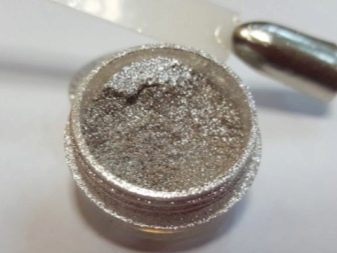
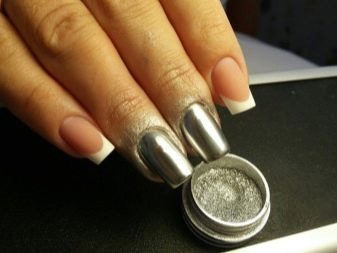
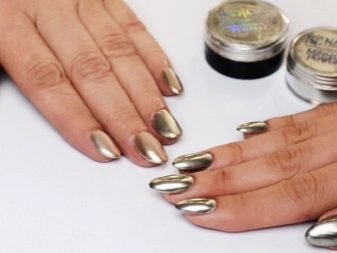
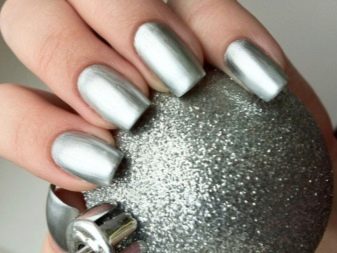
- Mirror polish or "chrome" nails. The masters tried to achieve a mirror effect on the nails in different ways: with the help of glitters, foil, sequins, but an even smooth "mirror" can be created only with the help of rubbing. It gives the same glass and silver effect on the nail plate. The manicure looks unusual and fragile, although in fact the rubbing is holding firmly. You should not combine bright accessories on your nails with a mirror manicure. It is better to complement them with silver rings to match the coating. Rings can be with light stones and diamonds. Ornaments made of non-precious metals without stones are also suitable.
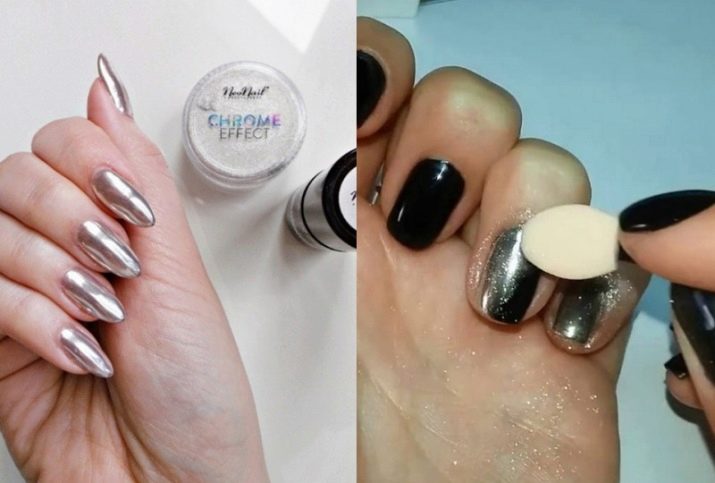
- Rub-chameleon (or "May beetle"). The peculiarity of this coating is that, in addition to smoothness and shine, the nails acquire a beautiful multifaceted color. Reflecting light, they shimmer in different colors, like the wings of a May beetle, hence the name. Chameleon coatings are rich in dark shades: emerald, blue, purple, black, dark olive. Several colors are simultaneously visible on the surface of the nail plate, since light hits the nails in different ways. The chameleon rub is combined with voluminous decorations, with other shades from its palette. For everyday wear, this is a controversial option, but at an evening event it will be very useful. It is noteworthy that in a jar the powder does not have this effect.It has an inconspicuous beige-gray color, and in all its glory it reveals only on the nails.

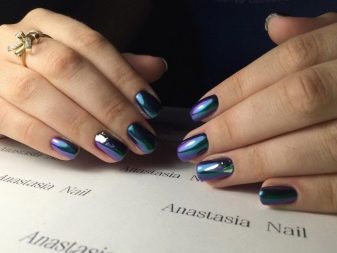
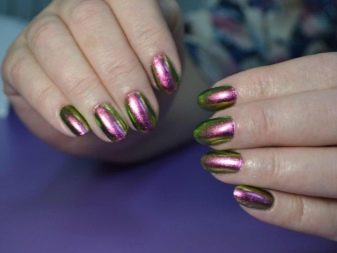
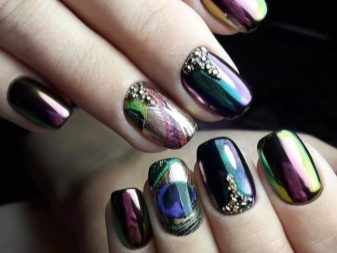
- Holography (or "Prism"). To describe the effect of holographic rubbing, it is enough to remember the reverse side of the CD-disc. In the classic design, the manicure looks like a silvery coating with colored tints. You can diversify the manicure with a colored base or rub in with bright pigment, but the effect of an iridescent rainbow on the nails will remain. A manicure with this effect is relevant in the cold season, especially on New Year's holidays. It shimmers like snow in the sun, and reminds of a winter fairy tale. It is possible to combine iridescent "winter" shades with white, silver, bluish decor. For example, beads or melange. Velvet sand and matte details are also relevant.
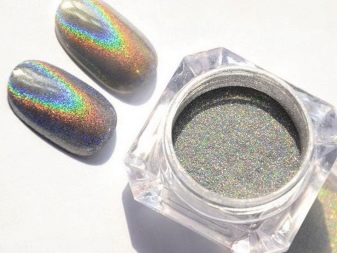

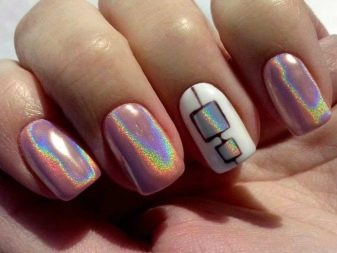

- "Cat's Eye". A few years ago, magnetic manicure gained popularity. The special varnish contained magnetic particles. The kit included sticks with magnets that helped create beautiful stains on the nails. Rubbing in with a similar effect is a more modern way to quickly create the popular "cat flare". However, it also involves the use of a magnetic stick. The advantages of rubbing in over gel polish with a similar effect is that the powder is consumed sparingly, and a clear pattern is obtained the first time. A bright highlight can be achieved on the basis of a good quality simple varnish and any gel varnish.
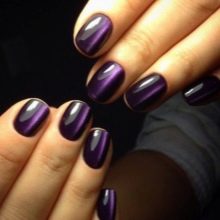

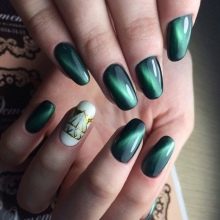
- "Northern Lights". Rub in different colors, mostly dark, the surface of which shimmers from a light gradient to a dark one, like a shine. The palette of this type of polyester powder is not rich. These are mainly shades of blue, green and red. "Northern Lights" harmoniously combines with glitters, rhinestones, sparkles that resemble sparkling ice and stars in the night sky.
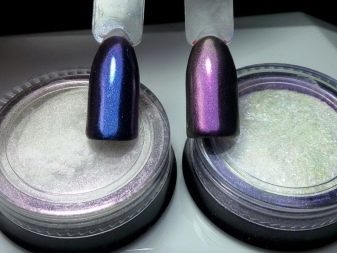
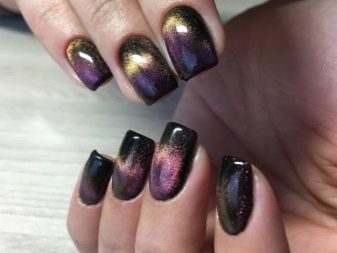
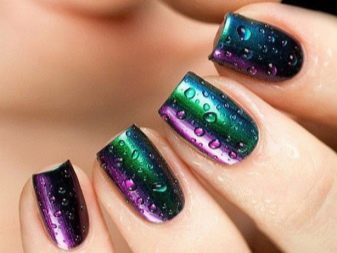
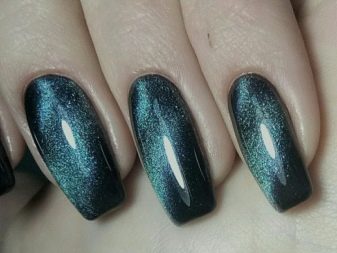
- "Liquid diamond" - rub in with the effect of Hollywood chic. The powder contains particles of different sizes, from pollen to flakes. They are distinguished by the brightest shine, so the nails literally sparkle after application. You can compare such a manicure with a foil or "broken" coating, but it looks more expensive and neat.
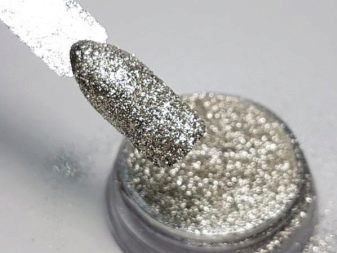
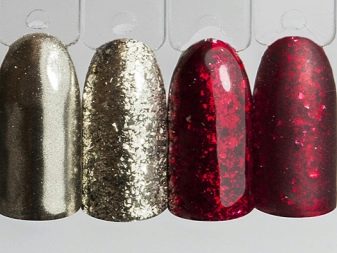
Advantages and disadvantages
The use of rubbing already deserves attention due to the peculiarities of the technology. It has a twist. She makes others wonder how you can create such beauty on your nails and how much time was spent on it. And in most cases, those who do not yet know about rubbing are mistaken. At first glance, it seems that performing a mirror manicure is difficult, time consuming and expensive.
Three main advantages of rubbing in: simple application technology, affordable price and quick results.
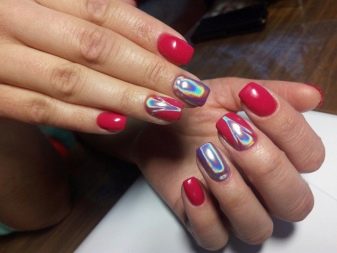

In addition, rubbing has a number of other advantages.
- Wide possibilities of her art. The material is malleable, the color palette is varied, so you can bring the most daring ideas to life.
- Versatility. Any type of rub is suitable for use on all surfaces. It can be ordinary enamel, which does not require polymerization in a lamp, gel varnishes, biolacs, shellacs. It is important to consider only the composition of the enamel. It should not contain acetone - it will corrode the powder particles.
- Long lasting manicure. The nail design will last as long as the base. For enamels, the period is short - a week or one and a half. You don't have to think about a new manicure with gel polish for at least three weeks.
- Harmless composition. The rubbing does not come into direct contact with the nail plate. She cannot scratch her or do any other harm.

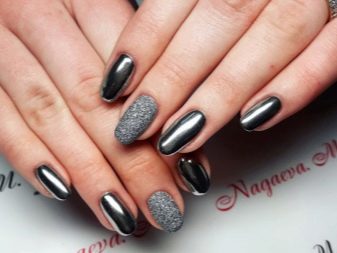
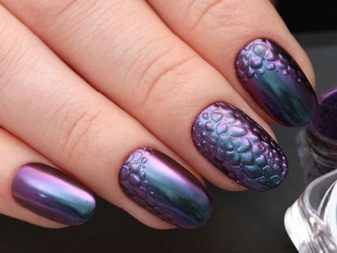
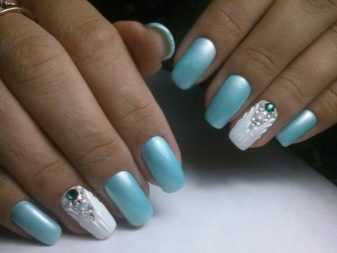
- Simple application technology. It takes practice to create drawings with colored powder, but even non-professionals can do a single-color coating.
- Looks beautiful on nails of any length and shape.
- Shine and pearlescent tints visually make nails denser, smoother and healthier.
- Economical consumption of funds.To spend the minimum amount of rubbing, you need to adapt to the bulk material, but this is not difficult to do.
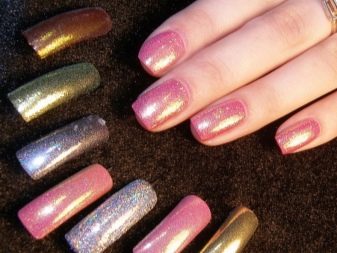
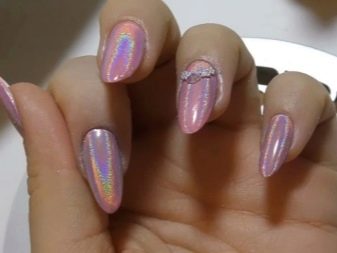
Rubs have fewer disadvantages than advantages. It can frustrate with an unpredictable result when combined with an acetone-based enamel. Also, at the first time of use, everyone notes the unusual way of applying the material, which you need to get used to.
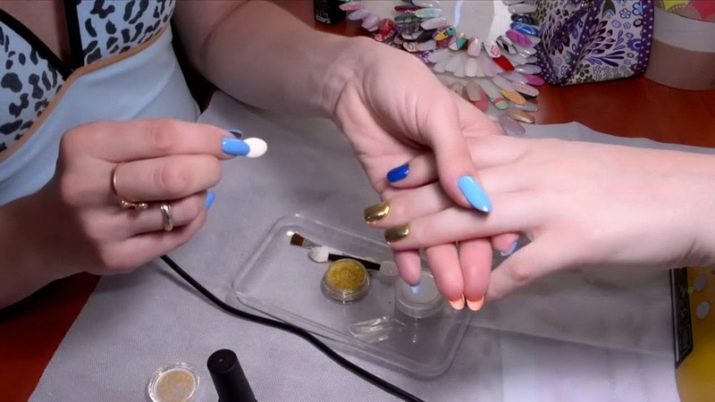
In rare cases, the rubbing does not stick to the nails. This may be due to poor quality material or characteristics of the body. Some types of gel polishes do not take root on the nails, and the decor leaves with them. You can correct this situation by choosing a suitable base and rubbing from a professional brand. Such a tool will cost more than from a Chinese site, but the effect justifies the cost of materials for the pros.
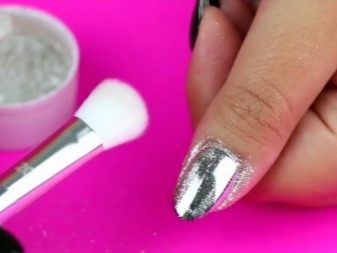

For girls who prefer enamel coatings, the disadvantage is that you need to buy a top. Without a sealing top layer, the rub-in will only last until the first hand wash.
Interesting nail design ideas
You can apply current trends in manicure at home. It is enough to take a classical technique and apply new material to it. And if there is no clear idea of the result, you can peep ideas from nail art masters.
The classic one-color finish on all nails looks stylish and appropriate in any setting. With the addition of rubbing in, this simple technique will sparkle with bright notes of shine and iridescent overflows.


Mirror shine, pearl and pastel shades are successfully integrated into everyday and festive looks.
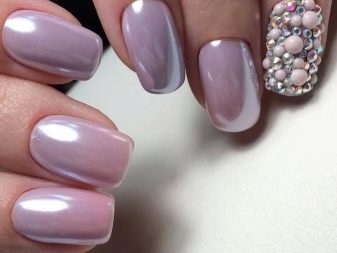
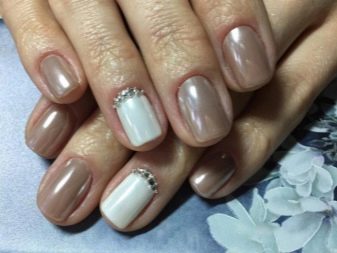
"Calico" coating is a good opportunity to apply a new solution in nail design. Rubbed in, it looks more luxurious than other techniques. That being said, matte manicure has many advantages. It lasts longer, suits any shape and length of nails, looks noble. In a matte finish, bright colors look muted. If it is difficult for office workers to decide on a colored manicure with a noticeable shine, then a matte one will not look defiant.
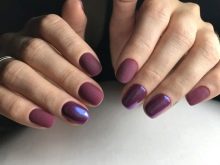
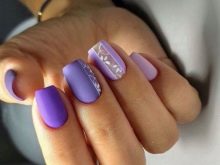

Mirror manicure is the most common option in rubbing techniques. The surface of the nail looks chrome.
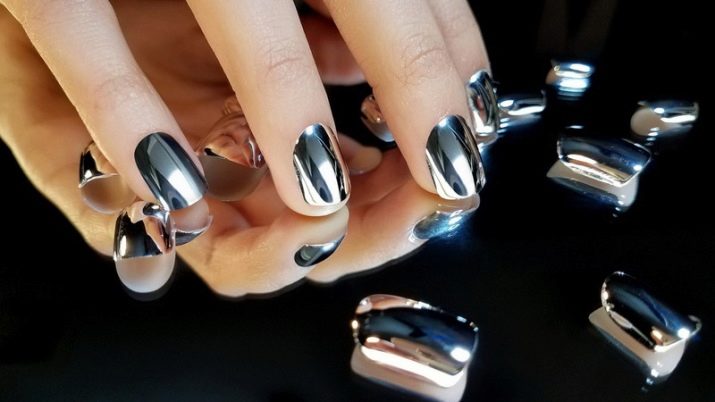
The mirror finish draws attention to the hands. Careless workmanship and defects will immediately catch your eye, so careful preparation is essential.
Glitters successfully accentuate the features of the rubbed design. Glitter and pearlescent coating on a light or transparent base visually make nails strong and healthy, therefore such a coating is a salvation for thin and brittle nails.

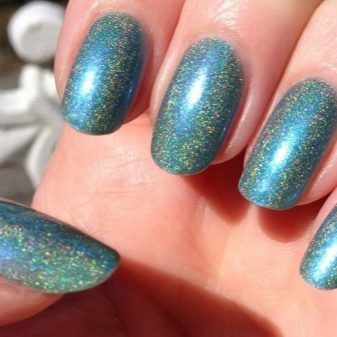
Various combinations of matte and glossy textures always look a win-win. They balance each other. A damp sheen on a muted base helps to add volume to the print, while matte patterns on gloss still look unusual.
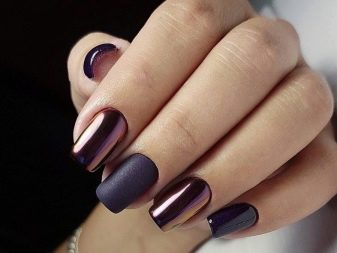
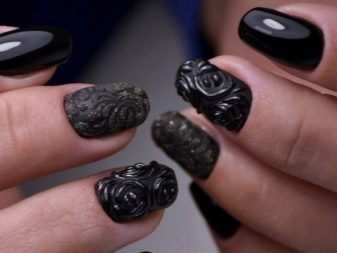
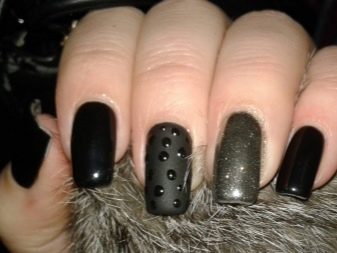

Popular motives can be used as patterns: geometry, origami, floral prints, classic monogram.
The combined jacket looks beautiful: a white matte plate and a silver or gold smile along the edge of the nail.
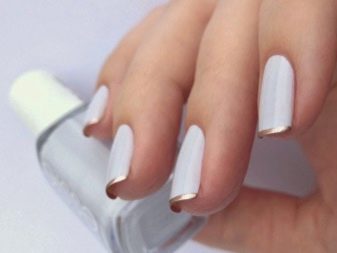
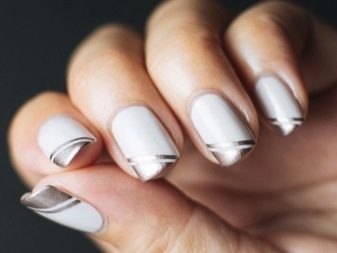
Another variation of this combination is a reverse jacket. It is available in two variations: a matte “smile” and a glossy surface of the nail, and a similar version in a mirror image.
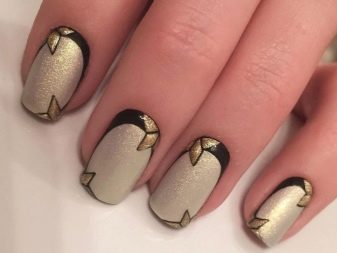
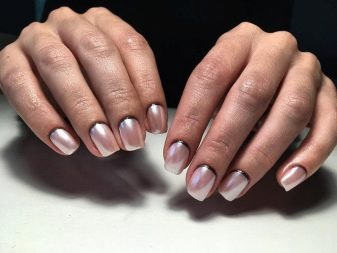
Both types of service jacket, classic and reverse, can be complemented with rhinestones, sparkles, more complex decor.
The author's technique of manicure with negative space has arisen recently. Its essence lies in the fact that the nail plate is partially covered with color, while the other part of it remains “naked” or “empty”.
There are two types of stencils for this technique. The first one allows you to apply the pattern on a transparent base, and the second one allows you to leave an empty space on the colored nail plate.
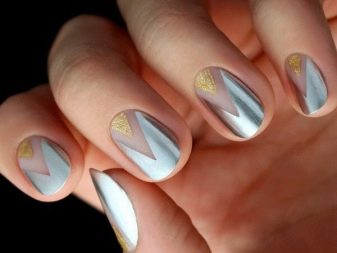
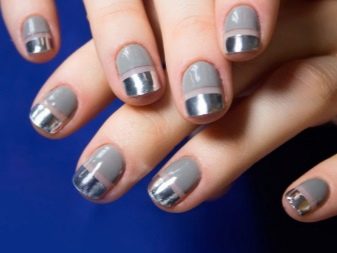
Rubbing with this technique is more difficult to use. You will have to make more layers, since the stencil cannot be applied to a still sticky base.
Stamping manicure is a type of stencil manicure. It involves the use of special silicone or metal applicators. The applicator is engraved with an ornament that is transferred to the nail. Usually acrylic paints or colored varnishes are used for this purpose. Working with rubbing is more difficult than with liquid consistencies, but the result is worth the effort.
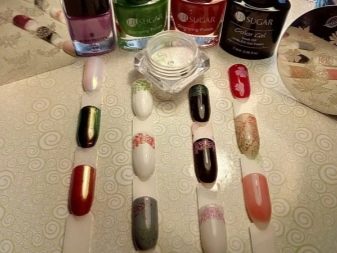
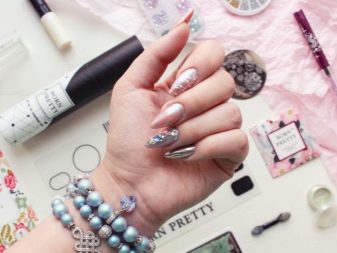

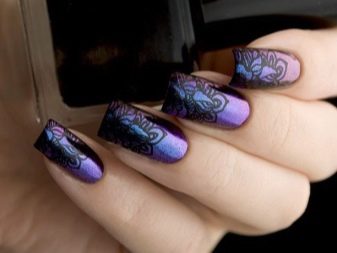
Decals are best used on a plain surface. For dark stickers, light bases are suitable, for light ones - contrasting ones. Also on light colors, elements in the color of gold and silver look luxurious.
Do not apply the sticker directly to the rub. First, it is sealed with a glossy top, and ready-made patterns can be applied on top.


The patterns in the stickers are variable. Simple geometry and delicate flowers look harmonious on a bright basis.
The gradient technique is commonly known as Ombre. It involves the use of two or more colors or shades of the same color on the nail. The colors blend smoothly into each other, forming a beautiful stretch.
Rub-in is convenient for gradient manicure due to its powdery consistency. It is literally shaded on the nails.
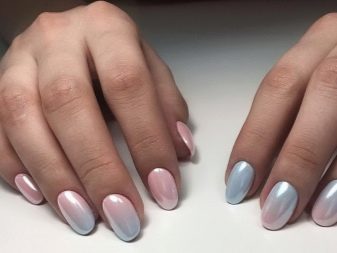
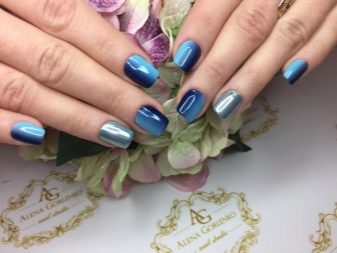
There is another type of gradient - each nail on one hand is covered with pigment a tone darker than the previous one.
How to use?
At home, the use of rubbing involves several stages. Not all of them are directly related to design work. Preparation is a big part.
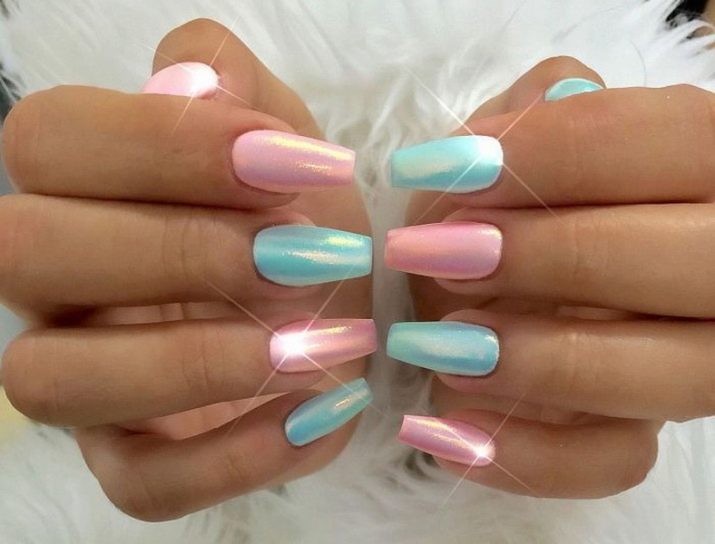
Choice of coating and design tools
To implement nail ideas, you will need a coating, rubbing, tools for preparing nails, a small set of tools for working with pigmented powder. A simple varnish, gel, shellac or acrylic is suitable for the role of the base. The choice depends on individual preferences. Be sure to have a high-quality top coating in the kit.
The rub is literally glued to the base, and the transparent top protects it from mechanical damage, water, and the sun.
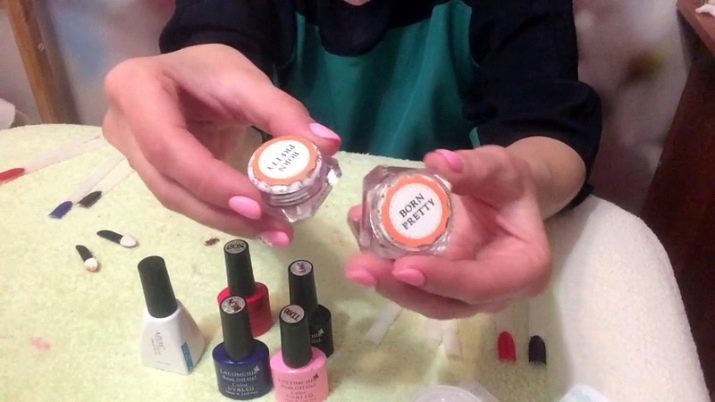
The rub is chosen depending on the desired effect. It is important to take into account that the product looks different in the jar than on the nails. To demonstrate the result, the seller must have test samples.
The finer the grind, the easier it is to apply to the substrate. The coating is denser and more uniform.
The manicure set must match the type of coverage. If the base is a regular varnish, a minimum set is sufficient. If you work on a gel, you need a llama, liquid to remove the sticky layer, special brushes and files for polishing gel nails.


Colored powder is collected and applied with an applicator or a brush. It can come in a kit with a tool, or it can be purchased separately. Brushes come in different sizes and materials.
It is more convenient to use brushes and an applicator when there is a little experience. At first, it is easier to drive in the powder with your finger (hence the high consumption at first). To prevent the rubbing from sticking to the skin, it is advisable to use silicone gloves.
You will also need a wide, fluffy brush to remove excess product from the nail plate.
For complex designs, you can use stencils and additional decor.
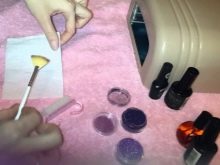
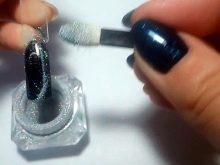

Preparation of hands and nails
Any manicure is done according to a certain scheme: preparation, base, decor, top application. Working with rub-in is no exception.
The preparation consists of basic techniques.
- Treat cuticles and rollers. The classic way is suitable for girls with normal skin on the hands. The European technique is more suitable for owners of delicate skin - when the cuticle is not cut off, but softened and pushed back with an orange stick. Hardware manicure is considered universal, but it is done on dry skin without steaming.
- Eliminate cosmetic defects of nails: remove irregularities, mask broken nails, cracks. The base under the varnish can be applied with any type of coating.
- Give the nails the desired shape.The choice of length and shape is determined by the condition of the nails and personal preference. Rubbing looks good on any nails.
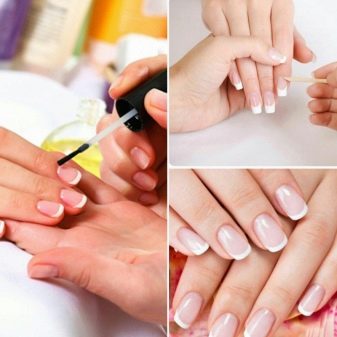
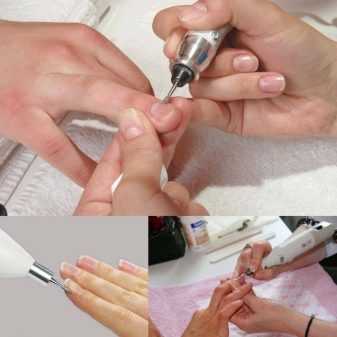
Rubbing application
The sequence of actions is different when using different materials as a base. Working with ordinary enamel is the fastest, and with gel polish - the most lasting result.
On the enamel.
- Apply base enamel to prepared nails in one layer. It should grip, but still sticky. If the layer is not smeared from the touch of your finger, you can proceed to the main stage.
- Pick up the powder with the applicator, sprinkle the nail in the varnish. Using the pad of your finger, gently pressing, rub in the pigmented mixture. The pressure should be light so as not to remove the cover.
- Remove excess powder with a brush.
- Apply a top coat.
- Allow all layers to dry completely. You don't need a lamp for this.
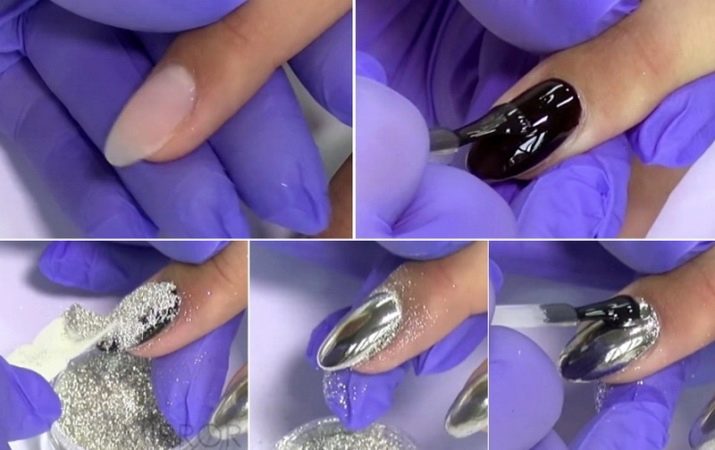
On gel polish.
- Apply and dry the base. It is important to "seal" the marigold along the edge.
- Cover in one layer with colored gel, cure in a llama.
- Without removing the sticky layer, spread a little rub over the nail. Rub in the pigment gently. To make the color brighter, you need to repeat the procedure.
- Brush off excess powder.
- Dry in a lamp, rub in (no longer than one minute).
- Seal the top coat with a glossy top and cure.
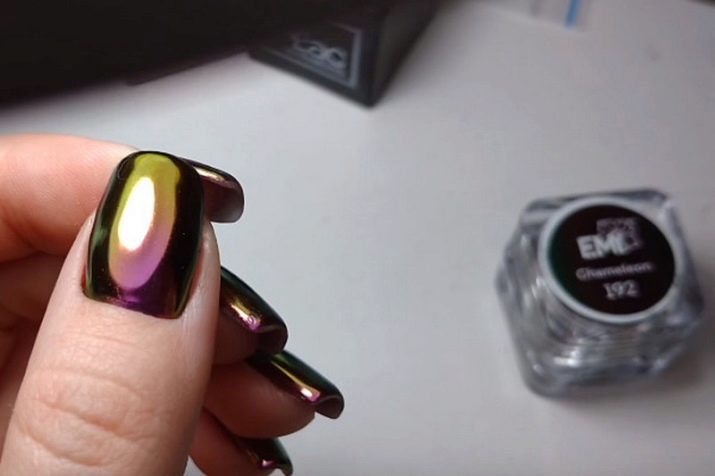
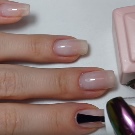
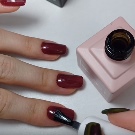

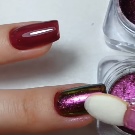
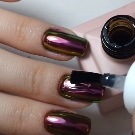
On acrylic and shellac, rub in is applied in the same way.
For information on how to properly apply a rub on gel polish, see the next video.








